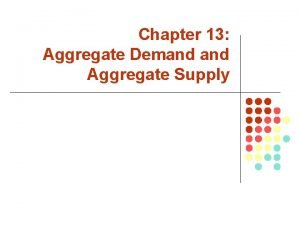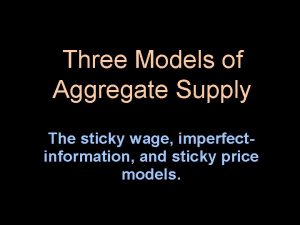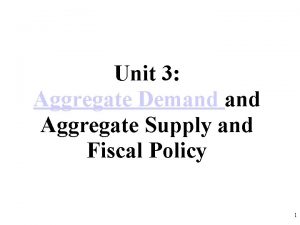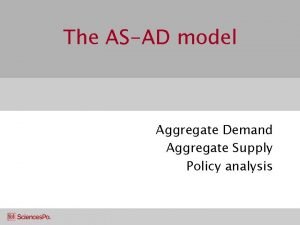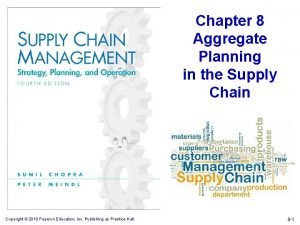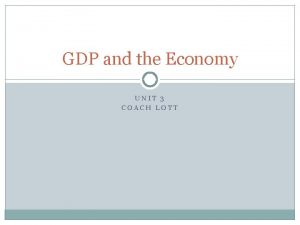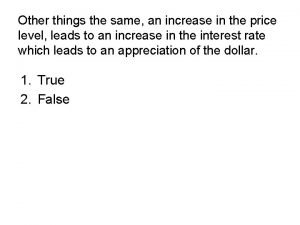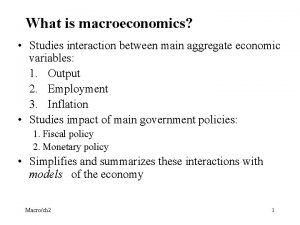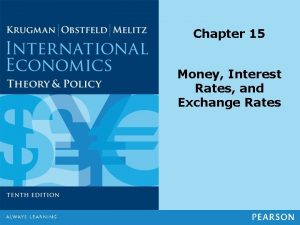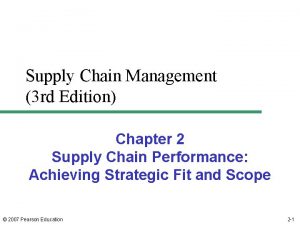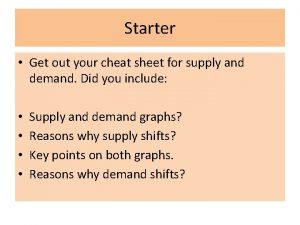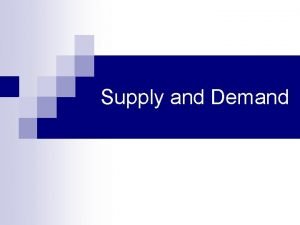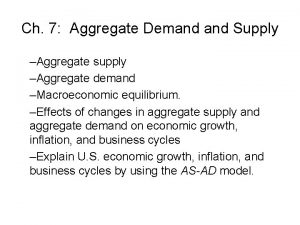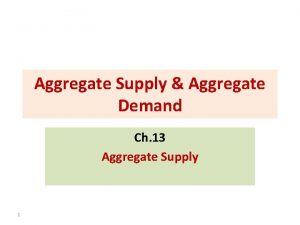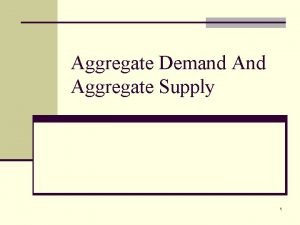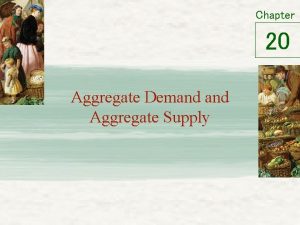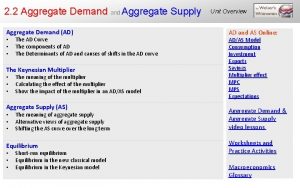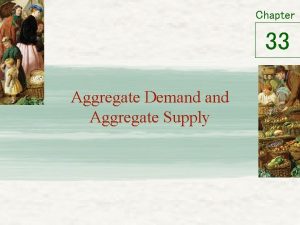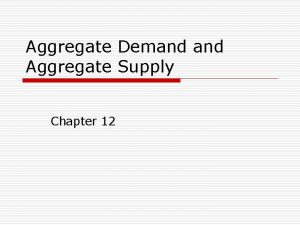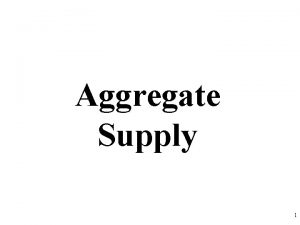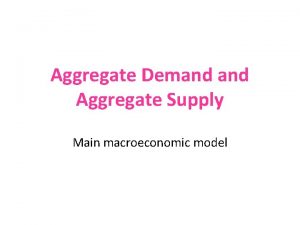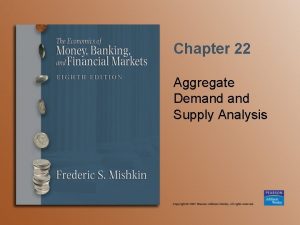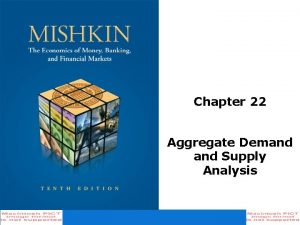Aggregate Demand Aggregate Supply 1 Aggregate Demand Aggregate




































- Slides: 36

Aggregate Demand Aggregate Supply 1

Aggregate Demand • Aggregate Demand refers to the quantity demanded of goods and services, or the quantity demanded of the Real GDP, at various price levels. 2

In other words, aggregate demand (AD) is the sum of demands of the households (C), firms (I), governments (G), and net exports (X-M). AD = C + I + G + (X-M) 3

Aggregate Demand Curve • The AD curve is downward sloping • It indicates a negative relationship between the price level and the quantity demanded of Real GDP. • As the price level rises, the quantity demanded of Real GDP falls, and as the price level falls, the quantity of GDP demanded 4 of Real GDP rises.

Why Does the Aggregate Demand Curve Has a Negative Slope (Downward Sloping)? Monetary Wealth Effect • A reduction in price level will increase people’s purchasing power. • When the purchasing power increases, the value of money increases, people become richer (wealthier) – this effect is called monetary wealth. • As a result, quantity demanded increases, GDP will also increase. • On the other hand, if the price level increases, purchasing power decreases, a person’s monetary 5 wealth will also decrease.

Why Does the Aggregate Demand Curve Has a Negative Slope (Downward Sloping)? International Trade Effect • Households consumption (C) and the firms’ investments (I) are sensitive to changes in interest rates. • If interest rates increase, cost of borrowing increases, loans become expensive. • Consumption and investment will reduce. These will lead to reductions in the quantity demanded and the GDP. • This effect is called the interest rate effect. 6

Why Does the Aggregate Demand Curve Has a Negative Slope (Downward Sloping)? International Trade Effect • The next factor that explains why the AD curve has a negative slope is the international trade effect. • This effect is established through foreign sector spending, which includes a country’s export and import. 7

A Change in the Quantity Demanded of Real GDP versus a Change in Aggregate Demand • A change in the quantity demanded of Real GDP is brought about by a change in the price level. This would cause a movement along the Aggregate Demand Curve, but would not shift the curve either to the right or left. • A change in the Aggregate Demand is the movement of the AD curve either to the right or to the left. An increase in AD is the shift of the curve to the right, while a decrease in AD would cause a 8 left shift to the curve.

A Shift in the Aggregate Demand Curve 9

Factors that shift the AD curve to the right or left. • If at a given price level, Consumption (C), Investment (I), Government Purchases (G), or Net Exports INCREASE, then Aggregate Demand will INCREASE as well. AD shifts to the right. • If at a given price level, Consumption (C), Investment (I), Government Purchases (G), or Net Exports DECREASE, the Aggregate Demand will DECREASE as well. AD 10

How Spending Components Affect Aggregate Demand? • Components of Spending: – – Consumption Investment Government Purchases Net Exports • A change in some or all of these components can affect aggregate demand. 11

What Causes Consumption to Increase? • Wealth • Expectations about Future Prices and Income • Interest Rate • Income Taxes 12

What Causes Investment to Increase? • The Interest Rate • Expectations about Future Sales • Business Taxes 13

What Would Increase Net Exports? • Foreign Real National Income: As exports rise, net exports rise, and so does the Real GDP. • Exchange Rate: whether or how far a different monetary unit has appreciated or depreciated when compared to your own monetary units. 14

Short Run Aggregate Supply (SRAS) 15

Short Run Aggregate Supply • The quantity supplied of all goods and services at different price levels. • The Short Run Aggregate Supply Curve is upward sloping. • It indicates a positive relationship between the price level and the real GDP (output). 16

Short-Run Aggregate Supply Curve 17

Why does the Short-Run Aggregate Supply Curve has a positive slope (upward sloping)? Wages • Higher wages will attract more new workers. At higher wages, current workers are willing to work more. • As a result, output will increase at higher wages compared to lower wages. 18

Why does the Short-Run Aggregate Supply Curve has a positive slope (upward sloping)? Prices • A decline in the price level is linked with a decrease in output, which is illustrative of an upward-sloping short run AS curve. 19

Why does the Short-Run Aggregate Supply Curve has a positive slope (upward sloping)? • Producer Misperceptions: Economists generally agree that producers will produce more output as their relative price of their good rises and produce less output as the relative price of their good falls. • If producers misperceive relative price changes, then a higher price level will bring about an increase in output, which is illustrative of an upward-sloping SRAS curve. 20

Why does the Short-Run Aggregate Supply Curve has a positive slope (upward sloping)? • Worker Misperceptions: if workers misperceive Real wage changes, then a fall in the price level will bring about a decline in output, illustrative of the upwardsloping curve. 21

Shifts in the Aggregate Supply Curve • Wage Rate: a rise in equilibrium wage rates leads to a leftward shift in the aggregate supply curve. • Price of Non-labour units: An increase in the amount non-labour input shifts the AS curve leftward. • A decrease in the amount non-labour input shifts the AS curve rightward, 22

Shifts in the Aggregate Supply Curve • Productivity: describes the output produced per unit of input employed over some time. • This causes the short run AS to shift rightward. A decrease in labour productivity means business will produce less output with the same amount of labour. 23

Shifts in the Aggregate Supply Curve • Supply Shocks: Major natural or institutional changes on the supply side of the economy that affect aggregate supply are referred to as supply shocks. • A supply shock might include a drought, a flood that reduce the supply and shift the AS curve to the left, or finding even more oil in the Middle East that shift the AS curve to the left. 24

How Short-Run Equilibrium In The Economy Is Achieved • Aggregate demand short-run aggregate supply determine the price level, Real GDP, and the unemployment rate in the short run. • In the short-run equilibrium point, the quantity demanded of Real GDP is equal to the short-run quantity supplied of Real GDP. • An increase in the short-run aggregate supply lowers the equilibrium price level and raises Real GDP. 25

The Unemployment Rate In The Short Run If all other factors are assumed to be constant (ceteris paribus): • a higher Real GDP level is associated with a lower unemployment rate (Since more workers are needed to produce more output (more Real GDP), fewer people remain unemployed and the unemployment rate drops). 26

The Unemployment Rate In The Short Run If all other factors are assumed to be constant (ceteris paribus): • a lower Real GDP level to be associated with a higher unemployment rate. (Since fewer workers are needed to produce less output, more people are unemployed and the employment rate rises). 27

Long Run Aggregate Supply • Wages and prices eventually become unstuck and misperceptions will turn to accurate perceptions: when this happens the economy is said to be in The Long Run. • An important question is: Will the Level of Real GDP the economy produces in the long run be the same as in the short-run? 28

Long-Run and Short-Run When the economy is neither in the Short. Run nor the Long. Run, the economy is in a state of disequilibrium. 29

QUESTIONS TO PONDER… 30

• Explain what happens to the Aggregate Demand curve if the value of Ringgit Malaysia appreciates (assume that the value of other currencies are constant)? • Explain what happens to the Aggregate Demand curve if personal income taxes decline. 31

• What can cause the economy to move from one short-run equilibrium position to another short-run equilibrium position? • Why does the AD curve is downward sloping while the AS curve is upward sloping? 32

• If wage rates decline, explain what happens to the short-run aggregate supply curve? • Give an example of an increase in labour productivity. 33

Identify what will happen to the price level and Real GDP when each of the following occurs: • Short-Run Aggregate Supply rises • Short-Run Aggregate Supply falls • Aggregate Demand rises • Aggregate Demand falls • Aggregate Demand rises by more than the Short-Run Aggregate Supply rises • Aggregate Demand falls by less than the Short-Run Aggregate Supply falls 34

• What happens to certain economic variables such as the price level and Real GDP, as the economy moves from one short-run equilibrium to another short-run equilibrium? • If the economy is in the short-run equilibrium, what path does it travel to long-run equilibrium? • How long does it take the economy to move from short-run equilibrium to long-run equilibrium? 35

• What is the difference between short-run equilibrium and longrun equilibrium? 36
 Chapter 33 aggregate demand and aggregate supply
Chapter 33 aggregate demand and aggregate supply Unit 3 aggregate demand aggregate supply and fiscal policy
Unit 3 aggregate demand aggregate supply and fiscal policy Aggregate demand and aggregate supply
Aggregate demand and aggregate supply Unit 3 aggregate demand aggregate supply and fiscal policy
Unit 3 aggregate demand aggregate supply and fiscal policy Unit 3 aggregate demand aggregate supply and fiscal policy
Unit 3 aggregate demand aggregate supply and fiscal policy Aggregate planning
Aggregate planning Long run aggregate supply curve
Long run aggregate supply curve Long run aggregate supply curve
Long run aggregate supply curve Aggregate supply and demand graph
Aggregate supply and demand graph Matching supply and demand in supply chain
Matching supply and demand in supply chain Module 5 supply and demand introduction and demand
Module 5 supply and demand introduction and demand Tableau cannot mix aggregate and non aggregate
Tableau cannot mix aggregate and non aggregate Which aggregate supply curve has a positive slope
Which aggregate supply curve has a positive slope Aggregate supply shifters
Aggregate supply shifters The sticky wage model
The sticky wage model Why is aggregate demand downward sloping
Why is aggregate demand downward sloping Asad model
Asad model Aggregate supply curve
Aggregate supply curve The aggregate supply curve is
The aggregate supply curve is Red tomato tools case study excel
Red tomato tools case study excel Chapter 5 section 1 supply and the law of supply
Chapter 5 section 1 supply and the law of supply Elastisidad ng suplay
Elastisidad ng suplay Aggregate demand curve
Aggregate demand curve What is expansionary monetary policy
What is expansionary monetary policy Which of the following shifts aggregate demand to the left?
Which of the following shifts aggregate demand to the left? Recessionary gap aggregate demand
Recessionary gap aggregate demand What is nominal gdp
What is nominal gdp The aggregate real money demand schedule l(r,y)
The aggregate real money demand schedule l(r,y) Aggregate demand curve
Aggregate demand curve Taylor rule formula
Taylor rule formula The aggregate real money demand schedule l(r,y)
The aggregate real money demand schedule l(r,y) Supply and demand activities
Supply and demand activities Tipse economics
Tipse economics Implied demand uncertainty in supply chain management
Implied demand uncertainty in supply chain management Supply and demand cheat sheet
Supply and demand cheat sheet Supply n demand
Supply n demand Matching supply with demand
Matching supply with demand













